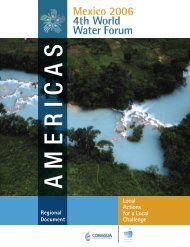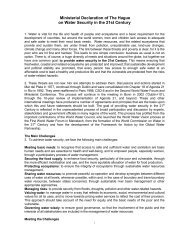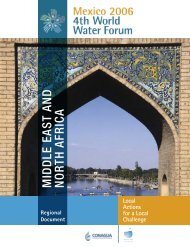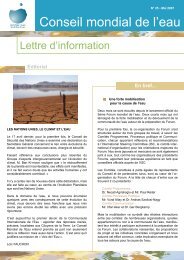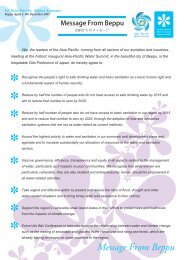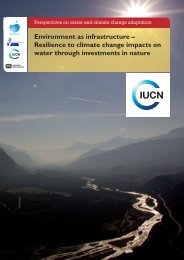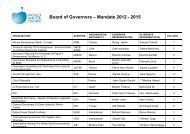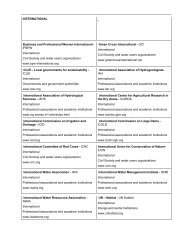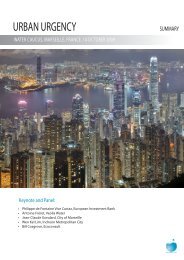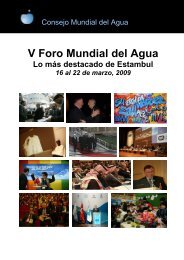the human right to water and sanitation in emergency situations
the human right to water and sanitation in emergency situations
the human right to water and sanitation in emergency situations
You also want an ePaper? Increase the reach of your titles
YUMPU automatically turns print PDFs into web optimized ePapers that Google loves.
how <strong>to</strong> ensure such protection. In more general terms, it endeavours <strong>to</strong> provide <strong>in</strong>formation that will facilitate<br />
<strong>the</strong> implementation of a <strong>right</strong>s-based approach as part <strong>and</strong> parcel of an <strong>emergency</strong> response <strong>and</strong><br />
“call on <strong>human</strong>itarian ac<strong>to</strong>rs <strong>to</strong> look beyond <strong>the</strong>ir core m<strong>and</strong>ate <strong>and</strong> <strong>to</strong> have a holistic vision of <strong>the</strong> needs<br />
of <strong>the</strong> people <strong>the</strong>y have been asked <strong>to</strong> serve 101 ”.<br />
Thus, <strong>the</strong> Operational Guidel<strong>in</strong>es on Human Rights <strong>and</strong> Natural Disasters address all guarantees (unders<strong>to</strong>od<br />
<strong>to</strong> be of a civil <strong>and</strong> political nature, but also those which are economic, social <strong>and</strong> cultural) bes<strong>to</strong>wed<br />
upon populations affected by natural disasters by both <strong>human</strong> <strong>right</strong>s law <strong>and</strong> International Humanitarian<br />
Law. The document sets out key elements <strong>and</strong> offers practical guidance <strong>to</strong> <strong>human</strong>itarian staff on how <strong>to</strong><br />
ensure that <strong>right</strong>s related <strong>to</strong> <strong>the</strong> basic necessities of life are put <strong>in</strong><strong>to</strong> practice. The <strong>right</strong> <strong>to</strong> dr<strong>in</strong>k<strong>in</strong>g <strong>water</strong><br />
<strong>and</strong> <strong>sanitation</strong> is specifically built-<strong>in</strong>.<br />
The IASC Operational Guidel<strong>in</strong>es on Human Rights <strong>and</strong> Natural Disasters are targeted directly at ensur<strong>in</strong>g<br />
<strong>the</strong> respect, protection <strong>and</strong> practical implementation of <strong>in</strong>ternational <strong>in</strong>struments defend<strong>in</strong>g <strong>human</strong> <strong>right</strong>s<br />
<strong>in</strong> contexts of natural disaster. In so do<strong>in</strong>g, this document recognizes <strong>the</strong> <strong>right</strong> <strong>to</strong> <strong>water</strong> when it states that:<br />
“Dur<strong>in</strong>g <strong>and</strong> after <strong>the</strong> <strong>emergency</strong> phase of <strong>the</strong> disaster, adequate food, <strong>water</strong> <strong>and</strong> <strong>sanitation</strong> (…) should be<br />
provided <strong>to</strong> persons affected by natural disasters who are <strong>in</strong> need of <strong>the</strong>se goods <strong>and</strong> services 102 ”.<br />
Whilst it conta<strong>in</strong>s no mention of <strong>the</strong> <strong>right</strong> <strong>to</strong> <strong>water</strong> as such, <strong>the</strong> proviso entitled “Protection of Rights Related<br />
<strong>to</strong> Basic Necessities of Life (B.2. Provision of adequate food, <strong>water</strong> <strong>and</strong> <strong>sanitation</strong>, shelter, cloth<strong>in</strong>g<br />
<strong>and</strong> essential health services)” is directly aimed at ensur<strong>in</strong>g that people affected by natural disasters are<br />
not denied <strong>water</strong> or safe access <strong>to</strong> it.<br />
Table 11 sets out <strong>the</strong> key pr<strong>in</strong>ciples that must be adhered <strong>to</strong> by <strong>human</strong>itarian aid personnel when implement<strong>in</strong>g<br />
<strong>water</strong> <strong>and</strong> <strong>sanitation</strong> services <strong>in</strong> <strong>emergency</strong> <strong>situations</strong>, as reflected under <strong>the</strong> above-mentioned<br />
Provision B.2.<br />
Table 11 - Guidance for implement<strong>in</strong>g <strong>the</strong> <strong>right</strong> <strong>to</strong> <strong>water</strong> <strong>and</strong> <strong>sanitation</strong> accord<strong>in</strong>g <strong>to</strong> <strong>the</strong><br />
operational Guidel<strong>in</strong>es on Human Rights <strong>and</strong> natural Disasters 103<br />
non-discrim<strong>in</strong>ation<br />
(B.2.1)<br />
Availability<br />
(B.2.1)<br />
Accessibility<br />
(B.2.1)<br />
Acceptability<br />
(B.2.1)<br />
Adaptability<br />
(B.2.1)<br />
- Part 2 - Def<strong>in</strong>ition of <strong>the</strong> <strong>right</strong> <strong>to</strong> <strong>water</strong> <strong>and</strong> <strong>sanitation</strong> <strong>in</strong> <strong>emergency</strong> <strong>situations</strong><br />
The pr<strong>in</strong>ciple of non-discrim<strong>in</strong>ation (of any k<strong>in</strong>d as <strong>to</strong> race, colour, sex, language, religion,<br />
political op<strong>in</strong>ion, etc.) must be respected when implement<strong>in</strong>g <strong>water</strong> <strong>and</strong> <strong>sanitation</strong><br />
services.<br />
Water <strong>and</strong> <strong>sanitation</strong> services must be made available <strong>to</strong> <strong>the</strong> affected population <strong>in</strong><br />
sufficient quantity <strong>and</strong> quality.<br />
“Water <strong>and</strong> <strong>sanitation</strong> services (a) are granted without discrim<strong>in</strong>ation <strong>to</strong> all <strong>in</strong> need, (b)<br />
are with<strong>in</strong> safe reach <strong>and</strong> can be physically accessed by everyone, <strong>in</strong>clud<strong>in</strong>g vulnerable<br />
<strong>and</strong> marg<strong>in</strong>alized groups, <strong>and</strong> (c) are known <strong>to</strong> <strong>the</strong> beneficiaries”.<br />
Water <strong>and</strong> <strong>sanitation</strong> services provided are culturally appropriate <strong>and</strong> sensitive <strong>to</strong> gender<br />
<strong>and</strong> age.<br />
Water <strong>and</strong> <strong>sanitation</strong> services are provided <strong>in</strong> ways flexible enough <strong>to</strong> adapt <strong>to</strong> <strong>the</strong><br />
change of needs <strong>in</strong> <strong>the</strong> different phases of <strong>emergency</strong> relief, reconstruction <strong>and</strong>, <strong>in</strong> <strong>the</strong><br />
case of displaced persons, return.<br />
101/ Protect<strong>in</strong>g Persons Affected by Natural Disasters, IASC Operational Guidel<strong>in</strong>es on Human Rights <strong>and</strong> Natural Disasters,<br />
June 2006, p. 9<br />
102/ Ibid. p. 22<br />
103/ Ibid. p. 22 <strong>and</strong> 23<br />
© ACF - THE HUMAN RIGHT TO WATER AND SANITATION IN EMERGENCY SITUATIONS<br />
73



